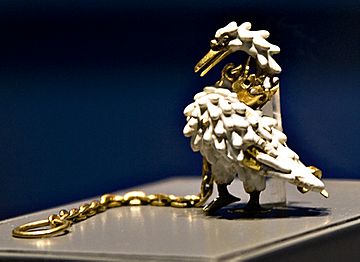Bastard feudalism facts for kids
Bastard feudalism is a term historians use to describe a new way of life in the Late Middle Ages, especially in England in the Late Middle Ages. It was a bit like the old feudal system, but with some big differences. Instead of land, people who served powerful lords got money, jobs, or influence. This meant that local leaders, called the gentry, started to feel more loyal to their lord than to the king. These followers were known as retainers, and a lord's whole group of followers was called their "affinity".
Contents
How Historians Talk About Bastard Feudalism
The Start of the Idea
The term "bastard feudalism" was first used by a historian named Charles Plummer in 1885. He thought this system caused a lot of the chaos and fighting during the Wars of the Roses in the 1400s. However, another historian, William Stubbs (who lived from 1825 to 1901), is most famous for talking about it.
Stubbs believed that things changed a lot under King Edward I (who ruled from 1272 to 1307). Before, kings would ask their nobles for soldiers. But under Edward I, nobles started getting paid by the king for military service. This meant that instead of fighting for their lord, people might pay money to their lord. Then, the lord would use that money to hire their own soldiers, creating a kind of private army.
A New Way to See It
In the 1940s, a historian named K. B. McFarlane offered a different idea. He said that "bastard feudalism" wasn't necessarily a bad thing. For McFarlane, it wasn't mainly about money, because the amounts were often small. Instead, it was about getting favors and support.
In those times, getting ahead often depended on who you knew. Serving a powerful lord was a great way to get jobs, land, or other benefits. Lords would hire people like administrators and lawyers. They also brought local gentry (people from important families) into their group of followers. By offering money instead of land, lords could afford to have many more followers.
What Retainers Gained
When someone became a retainer, they expected their lord to help them. This help could be in local arguments or even in court. This practice was called "maintenance." A retainer might wear a special livery badge or a fancy livery collar to show who they worked for. This could be very helpful, especially if they were in a courtroom!
Not Always Armies
Even though lords had many followers, these groups were not always ready for battle. Kings didn't have large standing armies back then. So, they often relied on these noble groups for soldiers when they needed to fight wars or stop rebellions.
However, if a king was weak, like Henry VI, powerful nobles could use their followers to challenge the king. For example, Richard, Duke of York (1411–1460) and Richard, Earl of Warwick (1428–1471) used their networks of followers to gain power. Local fights between gentry often grew bigger when they joined different powerful lords. These private arguments sometimes turned into battles during the Wars of the Roses. For instance, the followers of Richard, Earl of Salisbury, who fought in his dispute with the Percy family, were later called upon to fight against the King in 1459.
How It Ended
Edward IV (who ruled from 1461–1470 and 1471–1483) tried to limit how many followers nobles could have, but he didn't fully succeed. However, Henry VII (who ruled from 1485–1509) was much more successful. He made powerful nobles pay fines if they had too many unruly followers. In 1504, Henry also passed a law saying that only the King could have retainers. Nobles had to ask for a special license and pay for it if they wanted followers. By the early 1600s, bastard feudalism had mostly disappeared.
See also


